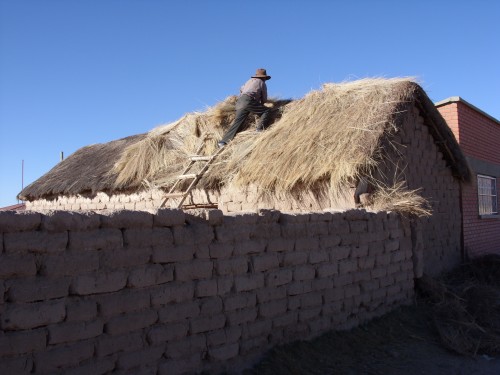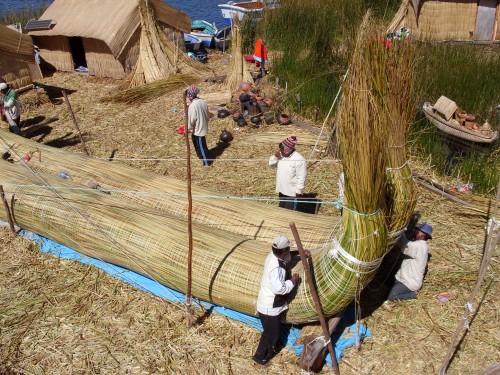En los primeros tiempos de la colonia, los Urus vivían alrededor de los lagos Titicaca y Poopó, a lo largo del río Desaguadero y cerca del lago Coipasa. A pesar de habitar una región donde la agricultura data de mucho tiempo y pese a compartir el área con los Aymaras cuya subsistencia alimenticia es basada en la agricultura y ganadería, en tiempos pasados los Urus vivían sobre todo de la pesca, cazando animales y recolectando huevos silvestres. Hasta el día de hoy, entre todos los grupos de Urus esas tradiciones de caza y pesca mantienen un alto valor cultural, aunque su importancia económica ya varía de grupo en grupo.
Durante las últimas décadas, los grupos Urus que aún quedan y que antiguamente permanecían aislados, comenzaron a sentir una identidad común. Se realizaron varios encuentros de todos los grupos Urus e incluso se organizaron reuniones para los niños.
Chipaya y Ayparavi
La gente de Chipaya y Ayparavi conforma el único grupo de Urus que aún mantiene su idioma tradicional. Este grupo está dividido en cuatro partes o ayllus y se rige por una tradición fuertemente igualitaria que implica un elaborado sistema de limitar y compartir el poder. En cuanto a su abastecimienta alimentación, complementan la pesca y la caza de aves con el cultivo de quinua y cañawa (dos cultivos andinos) y la crianza de ovejas, llamas y cerdos. Muchos pueblerinos de Chipaya y Ayparavi temporalmente migran a Chile para trabajar de jornaleros, una tendencia que empezó a hacerse cada vez más fuerte a partir de los años 1970, cuando las comunidades perdieron una parte de su territorio en conflictos con las vecinas comunidades aymaras.
Desfile de niños engalanados con el atuendo tradicional de Santa Ana de Chipaya
Urus del lago Poopó
Los Urus del lago Poopó se dividen en tres comunidades situadas en la orilla al este del lago Poopó. A pesar de que aún basan su subsistencia alimentaria en la pesca y en la caza de animales acuáticos, hoy en día los hombres frecuentemente migran a las ciudades en busca de trabajo. Los Urus del lago Poopó viven en extrema pobreza y sufren una fuerte discriminación de parte de sus vecinos Aymaras. Lo que empeora su situación es la contaminación del lago Poopó causado por las empresas mineras. Asimismo, el derrame de petróleo luego de la ruptura de un oleoducto en el año 2000 y los cambios climáticos agravan la situación.
Hombres de Llapallapani reparando un techo de caña
Los Urus de Irohito
Irohito es una pequeña comunidad de Urus situada a orillas del río Desaguadero, cerca del lago Titicaca. En el siglo XX, los Urus de Irohito cambiaron su idioma por el Aymara. La última hablante de su lenguaje ancestral, Julia Vila, falleció en el año 2004. La gente aún recuerda algunas palabras y expresiones de este idioma y se está planificando un proyecto de revitalización lingüística basado en la variante hablada en Chipaya.
La gente de Irohito ha preservado sus tradiciones de cazar y pescar, pero últimamente ha disminuido la cantidad de peces, hecho que condujo a problemas económicos en el pueblo, ya que el pescado había sido el único producto que los habitantes Urus podían vender en el mercado. Para resolver este problema, la población de Irohito empezó a criar ganado, dando de comer a los animales las plantas acuáticas que cortan en el río. Sin embargo, la gente joven generalmente prefiere irse del pueblo y migrar a la ciudad de El Alto.
Juana Vila, la hermana de la última hablante activa. Ella aún recuerda algunas palabras y frases del idioma tradicional.
Urus en las islas flotantes en la bahía de Puno
En términos económicos, los Urus que viven en las islas flotantes en la bahía de Puno, son los más prósperos. Sus islas se han transformado en uno de los mayores atractivos turísticos del país. Hablan Aymara como idioma materno. Es usual que los Urus estudien turismo e idiomas extranjeros en la ciudad adyacente de Puno.
Construcción de una balsa de totora en las islas flotantes
Hoy en día, esas balsas son utilizadas para el traslado de turistas entre las diferentes islas flotantes. Tradicionalmente, eran fabricadas exclusivamente de totora, una especie de caña, pero en el presente es usual llenarlas de botellas de plástico vacías para aumentar su capacidad de carga y prolongar su vida útil.






